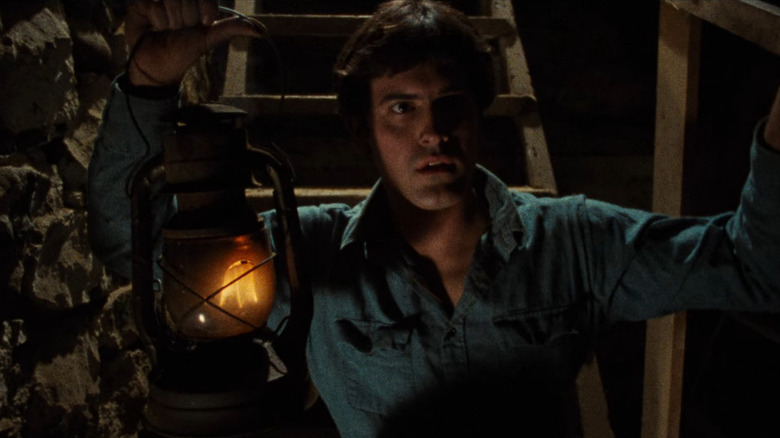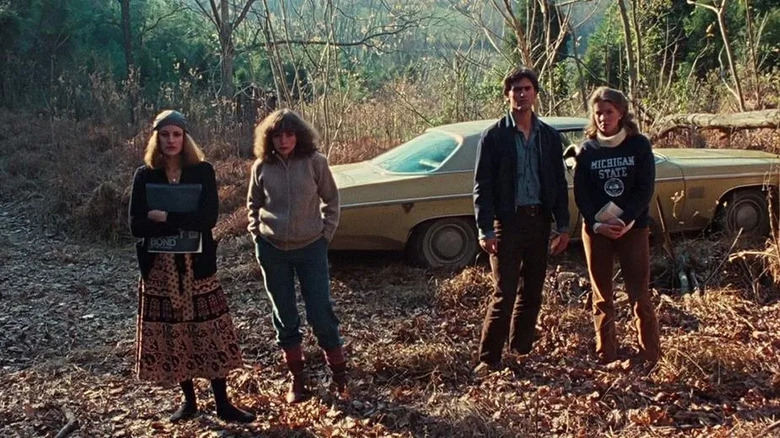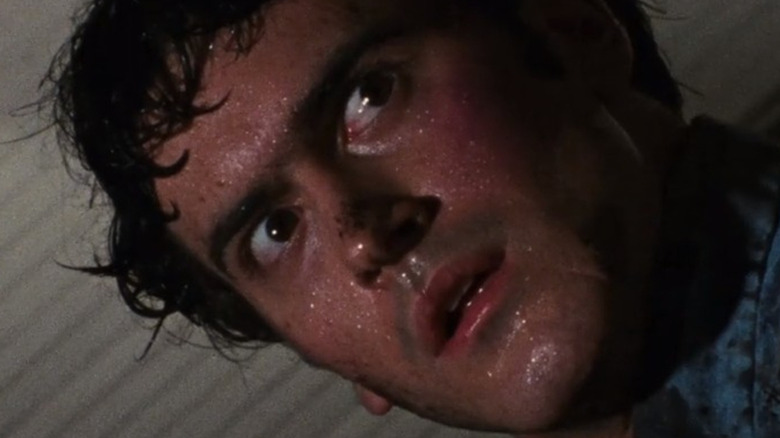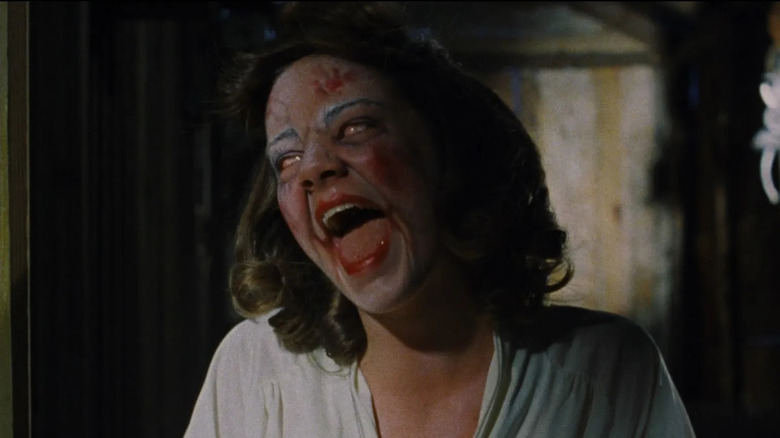Sam Raimi Never Thought Fans Would Love The Imperfections Of The Evil Dead Films
Movies are an illusion, and the generally accepted rule amongst filmmakers is that the illusion is never to be broken. Given the way movies are made — out of sequence, in arduous conditions over several weeks or months, with each work day stretching on for hours — it's no surprise that mistakes can occur. That's why Hollywood does its utmost to make sure as little imperfection remains on screen as possible, going as far as creating a job especially dedicated to that task: the script supervisor. The first script supervisor (originally known as "continuity girl") was Sarah Y. Mason, employed on the film "Bound in Morocco" in 1918.
61 years later, director Sam Raimi traveled to Morristown, Tennessee to begin work on his first full-length feature, "The Evil Dead." The film was not a big Hollywood production; Raimi, along with his fellow producers Bruce Campbell and Rob Tapert, were independent mavericks looking to break into the movie industry with "the ultimate experience in grueling terror," as the film's credits state. As legend has it, the shoot, originally planned for about a month, stretched on to upwards of twelve weeks, with the production bleeding cast and crew members toward the end of principal photography.
Raimi and company barely had the funds and stamina to complete the picture, never mind hiring a script supervisor. As such, the original cut of "The Evil Dead" had quite a few gaffes and mistakes visible on camera, elements that Raimi corrected for subsequent home media releases of the film. Yet, as the director has discovered over time, fans of the film have embraced those imperfections, folding them into the greater lore surrounding the movie and its makers.
The bridge gaffe joins the Raimi lore
At this point, loving Sam Raimi's films means much more than just, well, loving his films. Sure, fans and critics alike enjoy picking up on Raimi's many recurring traits and themes: stylistic camera tricks, references to the "Three Stooges," stories about characters who are arrogant cowards, and so on.
Yet there's also a game of sorts that's been made out of finding the more surface-level elements that keep popping up in Raimi's movies. There's the "Fake Shemp" credit (a credit that typically refers to a stand-in replacing an actor for a shot, named after Shemp Howard of the later "Three Stooges" shorts, who was infamously replaced by stand-ins after his demise), the ubiquitous Bruce Campbell cameo, and of course, the appearance of Raimi's "classic" car, a yellow 1973 Delta 88 Oldsmobile, which Raimi attempts to work into every one of his features.
If "The Evil Dead" is the bible from which all the Raimi lore has sprung, it only follows that fans would pore over every frame of the film, both looking for Easter eggs and gaffes in the margins as well as attempting to deconstruct the hand-made quality of the movie itself. One of the most noticeable goofs in the original cut of the film is the appearance of producer Rob Tapert standing near the bridge which Ash (Bruce Campbell) and his pals cross in the Delta on their way to the fateful cabin. However, Raimi had Tapert's appearance digitally removed from all home media releases beginning with the 2010 Blu-ray release, making his absence even more noticeable for such detail-obsessed fans.
'I never imagined it would reach such an elevated status'
Removing Tapert's accidental appearance in "The Evil Dead" was just one of a number of alterations Raimi had digitally made to the film in 2010, as this video demonstrates. Granted, these are all relatively minor changes of a cosmetic nature, and hardly the type of revisionist work that folks like George Lucas have become infamous for. Yet, thanks to fans who had fallen in love with the film and its imperfections over the years, these changes became more noticeable than most.
Raimi was recently asked about these changes point-blank during the Reddit AMA for "65," the upcoming film by directors Scott Beck and Bryan Woods which Raimi produced. As he explained:
"It's always a confusing thing for me because everything I do in the movie is about making it more effective and pulling the audience into the story. So, when I have the opportunity to digitally improve the film in a way I couldn't before I use the new tool that's at hand. And even though I've always known that people appreciate the practical effects and the handcrafted natural [aesthetic] of the 'Evil Dead' films, I still thought it was my job as director to do everything I could to approve [sic] the film at any time possible. I never imagined it would reach such an elevated status that the mistakes made within the film itself were part of the experience and the beauty of the thing."
The joy of continuity errors
Aside from the lore surrounding Raimi and his films, there's the simple fact that continuity errors are one of the favorite pastimes of the avid movie watcher. Sure, there's a dark side to spotting mistakes — in addition to the filmmakers potentially being embarrassed about them, there can be an arrogance to those who eagerly point out errors, with people acting as if they're better than the filmmakers. That path leads straight to CinemaSins, folks, and nobody wants that.
Instead, spotting goofs feels a lot like what Raimi described: they're "part of the experience and the beauty of the thing." Goofs are always going to turn up, no matter how many Script Supervisors are hired to monitor them, and rather than detracting from the film they can often add to the enjoyment. In some cases, like with the moment from "Aliens" where actor Lance Henriksen's body can be seen beneath a hole in the floor, such mistakes reinforce the power of craft and technique — as director James Cameron points out in his commentary for "Aliens," the mistake is forgiven because the audience is looking where they are "supposed to look."
Although the goof and other imperfections remain "fixed" in the most recent 4K Ultra HD and streaming versions of "The Evil Dead," perhaps Raimi's comments might mean he changes his mind about performing such fixes in the future, and maybe even reinstates the old gaffes in a future release of "The Evil Dead." The goofs are dead; long live the goofs!



